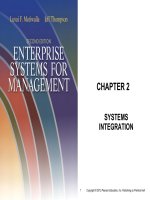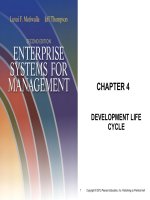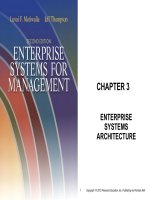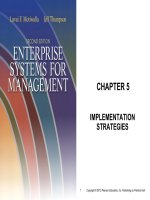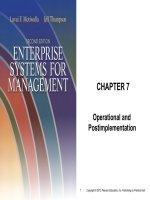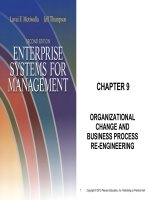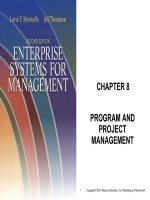Principles of operations management 9th by heizer and render chapter 11s
Bạn đang xem bản rút gọn của tài liệu. Xem và tải ngay bản đầy đủ của tài liệu tại đây (684.26 KB, 16 trang )
11
SUPPLEMENT
Supply Chain
Management
Analytics
PowerPoint presentation to accompany
Heizer and Render
Operations Management, Eleventh Edition
Principles of Operations Management, Ninth Edition
PowerPoint slides by Jeff Heyl
© 2014
© 2014
Pearson
Pearson
Education,
Education,
Inc.Inc.
S11 - 1
Outline
►
Techniques for Evaluating Supply Chains
►
Evaluating Disaster Risk in the Supply
Chain
►
Managing the Bullwhip Effect
►
Supplier Selection Analysis
►
Transportation Mode Analysis
© 2014 Pearson Education, Inc.
S11 - 2
Learning Objectives
When you complete this supplement you
should be able to:
1. Use a decision tree to determine the best
number of suppliers to manage disaster
risk
2. Explain and measure the bullwhip effect
3. Describe the factor weighting approach to
supplier evaluation
4. Evaluate cost-of-shipping alternatives
© 2014 Pearson Education, Inc.
S11 - 3
Evaluating Disaster Risk
▶ Many forms of potential disruptions
▶ For a given supply cycle, the probability of n
suppliers being disrupted is
P(n) = S+ (1− S)U n
S = the probability of a “super-event” that would disrupt all
suppliers simultaneously
U = the probability of a “unique-event” that would disrupt
only one supplier
L = the financial loss incurred in a supply cycle if all
suppliers were disrupted
C = the marginal cost of managing a supplier
© 2014 Pearson Education, Inc.
S11 - 4
How Many Suppliers?
▶ Portfolio of suppliers to balance costs and risks
▶ Evaluate one, two, or three suppliers using a
decision tree
S = 0.5%, U = 4%, C = $10,000, L =
$10,000,000
P(1) = 0.005 + (1 – 0.005)0.04 = 0.005 + 0.0398
= 0.044800, or 4.4800%
P(2) = 0.005 + (1 – 0.005)0.042 = 0.005 + 0.001592
= 0.006592, or 0.6592%
P(3) = 0.005 + (1 – 0.005)0.043 = 0.005 + 0.000064
= 0.005064, or 0.5064%
© 2014 Pearson Education, Inc.
S11 - 5
How Many Suppliers?
1 – P(1) = .955200
One supplier
$458,000
No failure
P(1) = .044800
Failure
1C = (1)$10,000 = $10,000
L + 1C = $10,000,000 + (1)$10,000
= $10,010,000
Two suppliers
$85,920
1 – P(2) = .993408
≤ 1 Fail
P(2) = .006592
Both fail
1 – P(3) = .994936
≤ 2 Fail
P(3) = .005064
Three suppliers
$80,640
© 2014 Pearson Education, Inc.
All three fail
2C = (2)$10,000 = $20,000
L + 2C = $10,000,000 + (2)$10,000
= $10,020,000
3C = (3)$10,000 = $30,000
L + 3C = $10,000,000 + (3)$10,000
= $10,030,000
Figure S11.1
S11 - 6
The Bullwhip Effect
▶ The tendency for larger order size fluctuations
as orders are relayed through the supply chain
▶ Creates unstable production schedules,
expensive capacity change costs, longer lead
times, obsolescence
▶ Damage can be minimized with supplier
coordination and planning
© 2014 Pearson Education, Inc.
S11 - 7
The Bullwhip Effect
Figure S11.2
60 –
50 –
Suppliers believe sales
are huge and respond
accordingly
Wholesalers order even more
to be sure retailers can be
adequately supplied
Suppliers
Order Quantity
40 –
30 –
Wholesalers
Retailers respond
by ordering more
Retailers
Consumers
20 –
10 –
0–
A short-term increase in consumer demand
|
|
1
|
2
|
3
|
4
|
5
|
6
|
7
|
8
|
9
|
10
|
11
Day
© 2014 Pearson Education, Inc.
S11 - 8
Managing the Bullwhip Effect
TABLE S11.1
The Bullwhip Effect
CAUSE
REMEDY
Demand forecast errors (cumulative
uncertainty in the supply chain)
Share demand information throughout
the supply chain
Order batching (large, infrequent
orders leading suppliers to order even
larger amounts)
Channel coordination: Determine lot
sizes as though the full supply chain
was one company
Price fluctuations (buying in advance
of demand to take advantage of low
prices, discounts, or sales)
Price stabilization (everyday low
prices)
Shortage gaming (hoarding supplies
for fear of a supply shortage)
Allocate orders based on past demand
© 2014 Pearson Education, Inc.
S11 - 9
RFID Helps Control Bullwhip
© 2014 Pearson Education, Inc.
S11 - 10
The Bullwhip Effect Measure
2
σ
Variance of orders
Bullwhip =
= 2orders
Variance of demand σ demand
If measure is:
> 1 – Variance amplification is present
= 1 – No amplification is present
< 1 – Smoothing or dampening is occurring
© 2014 Pearson Education, Inc.
S11 - 11
Calculating the Bullwhip Effect
▶ Transform sheet steel to tabletops
▶ Each firm in the supply chain has one supplier
and one customer
FIRM
VARIANCE OF
DEMAND
VARIANCE OF
ORDERS
BULLWHIP
MEASURE
Furniture Mart, Inc.
100
110
110/100 = 1.10
Furniture Distributors, Inc.
110
180
180/110 = 1.64
Furniture Makers of America
180
300
300/180 = 1.67
Chieh Lee Metals, Inc.
300
750
750/300 = 2.50
Metal Suppliers Ltd.
750
2000
2000/750 = 2.67
© 2014 Pearson Education, Inc.
S11 - 12
Supplier Selection Analysis
▶ Many factors play a role
▶ Choosing lowest bid is becoming rare
▶ Factor weighting techniques consider multiple
criteria
▶ Each factor is assigned a weight and a score
▶ Choose the supplier with the best weighted
score
© 2014 Pearson Education, Inc.
S11 - 13
Factor Weighting Approach
FABER PAINT
SMITH DYE
WEIGHT
SCORE (1-5)
(5 HIGHEST)
Engineering/innov
ation skills
.20
5
1.0
5
1.0
Production
process capability
.15
4
0.6
5
0.75
Distribution
capability
.05
4
0.2
3
0.15
Quality
performance
.10
2
0.2
3
0.3
Facilities/location
.05
2
0.1
3
0.15
Financial strength
.15
4
0.6
5
0.75
Information
systems
.10
2
0.2
5
0.5
Integrity
.20
5
1.0
3
0.6
CRITERION
Total
1.00
© 2014 Pearson Education, Inc.
WEIGHT
x SCORE
3.9
SCORE (1-5)
(5 HIGHEST)
WEIGHT
x SCORE
4.2
S11 - 14
Transportation Mode Analysis
▶ Evaluate holding verses shipping options
▶ Ship connectors from San Jose to Singapore
0.00
2
$
<
2
$1.9
pping
i
h
s
r
e
▶ Value of connectors = $1,750
low
s
e
s
o
o
Ch
▶ Holding cost = 40% per year
▶ One carrier is 1 day faster but $20 more expensive
Daily cost of
holding the =
product
Annual
holding x
cost
Product
value
= (.40 x $1,750)/365
= $1.92
© 2014 Pearson Education, Inc.
S11 - 15
All rights reserved. No part of this publication may be reproduced, stored in a retrieval system, or
transmitted, in any form or by any means, electronic, mechanical, photocopying, recording, or
otherwise, without the prior written permission of the publisher.
Printed in the United States of America.
© 2014 Pearson Education, Inc.
S11 - 16


